 |
 East Wing - Mississippi - and the Golden Age of Radio |
| Part One - 1930 - 1940; Mississippi discovers the magic in the air |
Today we think nothing of driving the 90 miles from Jackson to Meridian to do some shopping, or visit a favorite restaurant - at 70MPH - it's a simple hour and a half "trip". Between 1930 and 1950, Mississippi had very few paved roads - and a simple trip to town could turn into a full day's event - so travel was kept to a minimum. Strewn all around the countryside are little towns that were very nearly self contained. The smallest of these little communities always had a store, a gas station - and the Post Office. Some times the Post Office was IN the store... In slightly larger towns with a population around 300 to 1000, there was another store in town - the Western Auto. Towns with populations between 1000 and 10,000 often had yet another store - the Sears Catalog Outlet Store. The larger towns of course had department stores, music and radio stores, and so on. But a major segment of Mississippi's population at that time was in those smaller rural areas - like the first two described above. And that is where a very large number of radios were purchased - from the Sears (and Wards) catalog - delivered at the Post Office - and the local Western Auto. The Western Auto Stores of the old South were the original convenience store - they had everything! Car parts, plumbing, heating and electrical supplies; hunting and fishing stuff; toys, tools, and toe nail clippers. 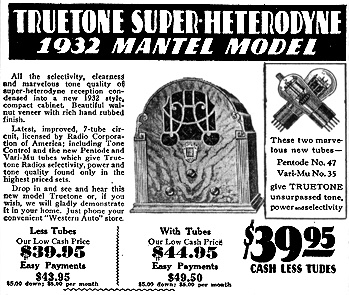 And as radio was entering "it's" Golden Age - TrueTone radios hit the shelves down at the Western Auto - Silvertone radios at Sears - and Airline radios at Wards. In 1930 (the 1930/31 Fall / Winter catalog) Western Auto introduced it's first non-automotive product - two radios - a 7 tube model for $65.50 - and a 5 tube radio for 49.95. The ad reproduced at right is from Western Auto's 1931 "Summer Thrift Book" which announced the radios being available in the stores. Magazines and newspapers carried ads for the stores in the larger cities - and for companies that would mail you a radio - or a radio Kit. Allied Radio started selling their KnightKits - as well as ready to play radios. But by far - the largest number of surviving old radios in Mississippi are the TrueTones. Here is an interesting bit of trivia: of all of the "old-time" radio sources - guess who you can still call and get service info from (hint: it ain't Sears!)... Western Auto Kansas City, MO. and the funny part is - guess who own (now) Western Auto??? Sears should learn from their newly acquired unit! Western Auto didn't manufacture radios, of course - their radios were made by several companies over the years. During the "golden age" three manufacturers supplied the bulk of Western Auto's radios: The "cheapie" sets mostly came from Belmont - a company that was very good at cutting costs... The Continental Radio and Television Company made many "mid-scale" sets - and the up-scale sets often came from Detrola. Detrola made sets for many companies - including Sears, Wards and Western Auto - as well as selling sets under their own brand name. There were, of course, many other brands sold - during this time - as the volume of sales of radios went from 3,789,000 units in 1930 to a peak of 16,000,000 units in 1947. It is estimated that there were some 132 million radios sold between 1930 and 1950. Western Auto alone sold some 4.5 million radios between 1930 and 1958 -- And as radio was entering "it's" Golden Age - TrueTone radios hit the shelves down at the Western Auto - Silvertone radios at Sears - and Airline radios at Wards. In 1930 (the 1930/31 Fall / Winter catalog) Western Auto introduced it's first non-automotive product - two radios - a 7 tube model for $65.50 - and a 5 tube radio for 49.95. The ad reproduced at right is from Western Auto's 1931 "Summer Thrift Book" which announced the radios being available in the stores. Magazines and newspapers carried ads for the stores in the larger cities - and for companies that would mail you a radio - or a radio Kit. Allied Radio started selling their KnightKits - as well as ready to play radios. But by far - the largest number of surviving old radios in Mississippi are the TrueTones. Here is an interesting bit of trivia: of all of the "old-time" radio sources - guess who you can still call and get service info from (hint: it ain't Sears!)... Western Auto Kansas City, MO. and the funny part is - guess who own (now) Western Auto??? Sears should learn from their newly acquired unit! Western Auto didn't manufacture radios, of course - their radios were made by several companies over the years. During the "golden age" three manufacturers supplied the bulk of Western Auto's radios: The "cheapie" sets mostly came from Belmont - a company that was very good at cutting costs... The Continental Radio and Television Company made many "mid-scale" sets - and the up-scale sets often came from Detrola. Detrola made sets for many companies - including Sears, Wards and Western Auto - as well as selling sets under their own brand name. There were, of course, many other brands sold - during this time - as the volume of sales of radios went from 3,789,000 units in 1930 to a peak of 16,000,000 units in 1947. It is estimated that there were some 132 million radios sold between 1930 and 1950. Western Auto alone sold some 4.5 million radios between 1930 and 1958 -- |
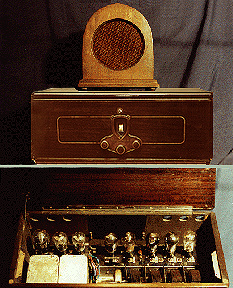 This radio is very typical of the first radio sets to use the (then) new AC Filament tubes, which allowed the radio to be powered from household AC current instead of batteries. Batteries had always been messy, expensive, and generally not very popular with the general public. AC powered radios like this 1928 American Bosch Model 28 (Made in 1928) helped to transform the radio from a workshop/basement curiosity - into a piece of furniture suitable for the living room. Bringing the radio into the center of the family set the stage for the great boom in radio sales - starting in 1930. The speaker shown with this radio is a 1926 Neutrowound speaker - one of the earliest "cathedral" shape speakers or radios. This speaker was designed for use with a battery set - as the magnetic field is generated by a permanent magnet. The Bosch Model 28 does not have a power supply for the soon to be standard electrodynamic speakers - so they are a good match. This radio is very typical of the first radio sets to use the (then) new AC Filament tubes, which allowed the radio to be powered from household AC current instead of batteries. Batteries had always been messy, expensive, and generally not very popular with the general public. AC powered radios like this 1928 American Bosch Model 28 (Made in 1928) helped to transform the radio from a workshop/basement curiosity - into a piece of furniture suitable for the living room. Bringing the radio into the center of the family set the stage for the great boom in radio sales - starting in 1930. The speaker shown with this radio is a 1926 Neutrowound speaker - one of the earliest "cathedral" shape speakers or radios. This speaker was designed for use with a battery set - as the magnetic field is generated by a permanent magnet. The Bosch Model 28 does not have a power supply for the soon to be standard electrodynamic speakers - so they are a good match. |
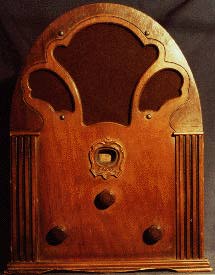 In 1930 Philco introduced their "Baby Grand" cathedral radio. It was a smashing success. Within a couple of years virtually all manufacturers had a version of the cathedral in their line. The 1932 Crosley Model 125 shown here - and the 167 below are examples from the Crosley Co. Powel Crosley was one of those very unusual Americans that come along every so often. Powel felt that most American companies were inefficient and wasteful - resulting in products that were priced too high. But unlike many of today's "consumer advocates" that just complain a lot - Powel did something. In 1921 he started building radios - and all the while he kept searching for ways to make better radios - cheaper. The Crosley Co. was very successful - and that is one reason there are many Crosley sets still around. The Crosley company was unusual in another way: unlike most companies that specialized in a single product or product line - Crosley was into everything. In addition to radios (and later televisions), the Crosley Co. made: one of the earliest facsimile machines; some "medical" devices - including the "Xervac Hair Growth Machine", Refrigerators - and similar stuff... Oh Almost forgot - Cars. Yup - you older folks may remember those cute very little Crosley Cars from the early 50's... like the station wagon that was less than 5 feet high - and only about 10 feet long... and CHEAP! In 1930 Philco introduced their "Baby Grand" cathedral radio. It was a smashing success. Within a couple of years virtually all manufacturers had a version of the cathedral in their line. The 1932 Crosley Model 125 shown here - and the 167 below are examples from the Crosley Co. Powel Crosley was one of those very unusual Americans that come along every so often. Powel felt that most American companies were inefficient and wasteful - resulting in products that were priced too high. But unlike many of today's "consumer advocates" that just complain a lot - Powel did something. In 1921 he started building radios - and all the while he kept searching for ways to make better radios - cheaper. The Crosley Co. was very successful - and that is one reason there are many Crosley sets still around. The Crosley company was unusual in another way: unlike most companies that specialized in a single product or product line - Crosley was into everything. In addition to radios (and later televisions), the Crosley Co. made: one of the earliest facsimile machines; some "medical" devices - including the "Xervac Hair Growth Machine", Refrigerators - and similar stuff... Oh Almost forgot - Cars. Yup - you older folks may remember those cute very little Crosley Cars from the early 50's... like the station wagon that was less than 5 feet high - and only about 10 feet long... and CHEAP! |
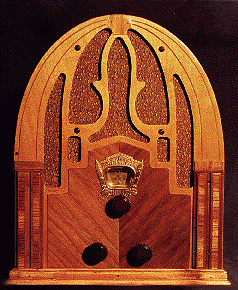 Meridian's Mystery House's RadioFor decades the unpainted Cyprus house on 8th street has quietly held secrets. What wonders had the sisters packed away in that old house? Few approached the house, and the few who did were usually dispatched with vigor. A Mississippi Power Co. employee once told of going to the house to replace the aging power meter. The exchange of meters should only take a few minutes - so his boss was concerned that he still wasn't back after a couple of hours. Since he was in the area, he stopped at the house and saw the service man standing, new meter still tucked under his arm, talking to someone through the front door, which was open just a crack. The door finally opened and the man disappeared inside. He emerged a few moments later and headed for his truck. Spotting his boss sitting there he hurried over and said "Sorry, Boss, took me a while to convince the dear lady that I really am from the power company -- and then she allowed me only one minute to change the meter. You know, I think she really would have come after me with that cane if I hadn't made it!" Years later, being unpainted and together with the eccentric reputation of it's owners -- the "Old Archer House" as it's become known, was a mystery and a source of endless speculation. Finally, in 1991 a court ordered sale of the estate revealed the truth. In many regards the speculation was short of reality. True treasures indeed emerged and found new homes. The "Old Archer House" was indeed a wonderful home to many. This fine Crosley Cathedral -- purchased new in 1933 -- is a part of that heritage. |
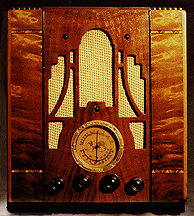 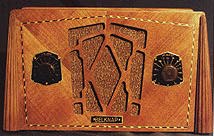 Atwater Kent radios were (and are) considered some of the best made. Atwater Kent was another "unusual" American - he felt very strongly that quality was the only way. If he couldn't sell quality - he just wouldn't sell anything. Unfortunately, companies like Crosley, Belmont Emerson and others were building radios for much less than Atwater Kent - a lot less... The two 1934 radios shown here are examples of the problem - The Atwater Kent Model 145 (on the left) sold for a "suggested" 39.90 - while the Belmont "Belknap 625" sold for a suggested 15.95. Granted - the AK had a lit dial - short wave - larger speaker - and one gorgeous cabinet - ( that is real walnut burl and the decorative bands are inlaid veneers... ) - but at something like twice to three times the price - the Atwater Kent Radios just couldn't compete. An interesting side note - when the Belknap was restored - it had to be modified to eliminate a dangerous -- and in today's world: illegal -- shortcut. The power cord in many of these "cheapie" sets contained a third "resistor" wire that for the tube filament string. The problem is that those cords get hot - the rubber gets hard - cracks off - and you can imagine the hazards at that point!. Underwriter Labs engineers would have a heart attack seeing something like this in a modern set. Didn't matter - it made for a cheaper set - and people bought them. A lot of them. By the end of 1936 Atwater Kent was out of business. Atwater Kent radios were (and are) considered some of the best made. Atwater Kent was another "unusual" American - he felt very strongly that quality was the only way. If he couldn't sell quality - he just wouldn't sell anything. Unfortunately, companies like Crosley, Belmont Emerson and others were building radios for much less than Atwater Kent - a lot less... The two 1934 radios shown here are examples of the problem - The Atwater Kent Model 145 (on the left) sold for a "suggested" 39.90 - while the Belmont "Belknap 625" sold for a suggested 15.95. Granted - the AK had a lit dial - short wave - larger speaker - and one gorgeous cabinet - ( that is real walnut burl and the decorative bands are inlaid veneers... ) - but at something like twice to three times the price - the Atwater Kent Radios just couldn't compete. An interesting side note - when the Belknap was restored - it had to be modified to eliminate a dangerous -- and in today's world: illegal -- shortcut. The power cord in many of these "cheapie" sets contained a third "resistor" wire that for the tube filament string. The problem is that those cords get hot - the rubber gets hard - cracks off - and you can imagine the hazards at that point!. Underwriter Labs engineers would have a heart attack seeing something like this in a modern set. Didn't matter - it made for a cheaper set - and people bought them. A lot of them. By the end of 1936 Atwater Kent was out of business.
|
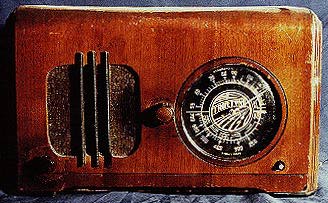 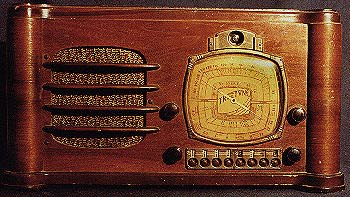 |
| TrueTone - From simple to very deluxe! Here are a couple of TrueTones. - The D-726 (left) from 1936 is a simple "kitchen table" radio. Yet as most radios of the day - it also had short wave. The world was fast becoming a dangerous place - and radio was bringing it into our homes. BBC London beamed daily broadcasts to the US, hoping to educate the "isolationist" American audience just how bad things were going in Europe. The D-727 (right) model shown here has just about every feature you could want in a "modern" radio - 8 tubes - three short wave bands: excellent coverage - Power tuning with push-buttons for eight pre-set stations... a large speaker for good sound... and one of those new fangled glowing "Green Eye" tuning indicators. This was really a console radio in a table-top cabinet. A very nice set - and available at your neighborhood Western Auto. The D-727 was made by the Detrola company - who also introduced the set under their own name that same year - the Detrola Model 175. They advertised that this set was the first "table set" to have power (motor driven) tuning. At 22"W by 12"H x 10" D and approximately 27 pounds -- it is one impressive table radio! |
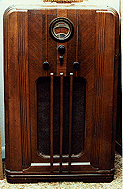 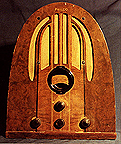 Philco became the largest manufacturer of radios about this time. The huge success with the Cathedrals - and a line of reasonably priced utility radios combined to boost Philco's sales past all competition. The console shown here is a mid-level - average family set. Seven tubes plus a shadow-meter tuning indicator - a two-speed tuning mechanism with the Philco "Beam-O-Light" tuning dial -- and a good hi-fi speaker system all combine to make this radio a joy to spend much time listening to. The Model 37-60 is the last year (almost) Philco made their famous Cathedral radios -- in 1976 Philco-Ford made one more model - a transistorized set celebrating Philco's 70th birthday. The Philadelphia Battery Company came a long way - from building crude batteries in 1906 - millions of radios, televisions, etc. on to working in the Space program in the 1960's. A proud tradition indeed! Philco became the largest manufacturer of radios about this time. The huge success with the Cathedrals - and a line of reasonably priced utility radios combined to boost Philco's sales past all competition. The console shown here is a mid-level - average family set. Seven tubes plus a shadow-meter tuning indicator - a two-speed tuning mechanism with the Philco "Beam-O-Light" tuning dial -- and a good hi-fi speaker system all combine to make this radio a joy to spend much time listening to. The Model 37-60 is the last year (almost) Philco made their famous Cathedral radios -- in 1976 Philco-Ford made one more model - a transistorized set celebrating Philco's 70th birthday. The Philadelphia Battery Company came a long way - from building crude batteries in 1906 - millions of radios, televisions, etc. on to working in the Space program in the 1960's. A proud tradition indeed!
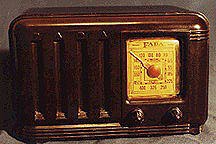 Something else was effecting the Radio industry at this time: Plastics. The new "cheaper" way to package those sets - colors - shapes - Shades of Art Deco!... The FADA company built many a plastic radio - such as this example here. This FADA 209 is a very common set - but because of a "twist of fate" - a radio that should be worth just a few dollars - can be worth a hundred or more - not because of it's own merit - but because it uses the same chassis as the much coveted (and ridiculously high priced) Catalin radio - in this case - the FADA Bullet - which often fetches $500+ dollars in today's (crazy) market. But at the time (1940) the manufacturers were all just looking for a way to distinguish their product from the crowd. Something else was effecting the Radio industry at this time: Plastics. The new "cheaper" way to package those sets - colors - shapes - Shades of Art Deco!... The FADA company built many a plastic radio - such as this example here. This FADA 209 is a very common set - but because of a "twist of fate" - a radio that should be worth just a few dollars - can be worth a hundred or more - not because of it's own merit - but because it uses the same chassis as the much coveted (and ridiculously high priced) Catalin radio - in this case - the FADA Bullet - which often fetches $500+ dollars in today's (crazy) market. But at the time (1940) the manufacturers were all just looking for a way to distinguish their product from the crowd. |
| The first "portable" radio is a subject that still causes a lot of debate. Several manufacturers claim the title - most hang the term "practical" along the way. By 1930 - several portables had been shown - and a few even sold. The term portable gets stretched a bit when you have to include batteries - in the 20's and 30's - even a minimal battery set would weigh 10 to 15 pounds - plus the radio! Zenith manufactured a "briefcase" radio in 1924 said to be the first portable "with built-in speaker". TravLer followed with a "suitcase" radio in 1925. But the portables didn't really get practical until some low power tubes were introduced in 1939 - 1940. By 1941 Zenith, Philco, and several others were producing nice portables - that were truly portable - and truly good radios. 1941 saw the introduction of the Zenith "Pocket-Radios" - cute little 4 tube AM radios. 1941 also saw the first of what became a dynasty: the mighty Zenith transoceanic All Wave Portable Receiver. |
|
WE INTERRUPT THIS PROGRAM TO BRING YOU A SPECIAL NEWS BULLETIN: THE JAPANESE HAVE ATTACKED PEARL HARBOR, HAWAII BY AIR; PRESIDENT ROOSEVELT HAS JUST ANNOUNCED.
THE ATTACK ALSO WAS MADE ON ALL NAVAL AND MILITARY ACTIVITIES ON THE PRINCIPLE ISLAND OF OAHU. PRESS THIS BUTTON to Hear-> |
|
| Express to the South Wing: The tour continues... |
|
Return to the Lobby  |
| Copyright © 1996, The Mississippi Historical Radio and Broadcasting Society. |

 And as radio was entering "it's" Golden Age - TrueTone radios hit the shelves down at the Western Auto - Silvertone radios at Sears - and Airline radios at Wards. In 1930 (the 1930/31 Fall / Winter catalog) Western Auto introduced it's first non-automotive product - two radios - a 7 tube model for $65.50 - and a 5 tube radio for 49.95. The ad reproduced at right is from Western Auto's 1931 "Summer Thrift Book" which announced the radios being available in the stores. Magazines and newspapers carried ads for the stores in the larger cities - and for companies that would mail you a radio - or a radio Kit. Allied Radio started selling their KnightKits - as well as ready to play radios. But by far - the largest number of surviving old radios in Mississippi are the TrueTones. Here is an interesting bit of trivia: of all of the "old-time" radio sources - guess who you can still call and get service info from (hint: it ain't Sears!)... Western Auto Kansas City, MO. and the funny part is - guess who own (now) Western Auto??? Sears should learn from their newly acquired unit! Western Auto didn't manufacture radios, of course - their radios were made by several companies over the years. During the "golden age" three manufacturers supplied the bulk of Western Auto's radios: The "cheapie" sets mostly came from Belmont - a company that was very good at cutting costs... The Continental Radio and Television Company made many "mid-scale" sets - and the up-scale sets often came from Detrola. Detrola made sets for many companies - including Sears, Wards and Western Auto - as well as selling sets under their own brand name. There were, of course, many other brands sold - during this time - as the volume of sales of radios went from 3,789,000 units in 1930 to a peak of 16,000,000 units in 1947. It is estimated that there were some 132 million radios sold between 1930 and 1950. Western Auto alone sold some 4.5 million radios between 1930 and 1958 --
And as radio was entering "it's" Golden Age - TrueTone radios hit the shelves down at the Western Auto - Silvertone radios at Sears - and Airline radios at Wards. In 1930 (the 1930/31 Fall / Winter catalog) Western Auto introduced it's first non-automotive product - two radios - a 7 tube model for $65.50 - and a 5 tube radio for 49.95. The ad reproduced at right is from Western Auto's 1931 "Summer Thrift Book" which announced the radios being available in the stores. Magazines and newspapers carried ads for the stores in the larger cities - and for companies that would mail you a radio - or a radio Kit. Allied Radio started selling their KnightKits - as well as ready to play radios. But by far - the largest number of surviving old radios in Mississippi are the TrueTones. Here is an interesting bit of trivia: of all of the "old-time" radio sources - guess who you can still call and get service info from (hint: it ain't Sears!)... Western Auto Kansas City, MO. and the funny part is - guess who own (now) Western Auto??? Sears should learn from their newly acquired unit! Western Auto didn't manufacture radios, of course - their radios were made by several companies over the years. During the "golden age" three manufacturers supplied the bulk of Western Auto's radios: The "cheapie" sets mostly came from Belmont - a company that was very good at cutting costs... The Continental Radio and Television Company made many "mid-scale" sets - and the up-scale sets often came from Detrola. Detrola made sets for many companies - including Sears, Wards and Western Auto - as well as selling sets under their own brand name. There were, of course, many other brands sold - during this time - as the volume of sales of radios went from 3,789,000 units in 1930 to a peak of 16,000,000 units in 1947. It is estimated that there were some 132 million radios sold between 1930 and 1950. Western Auto alone sold some 4.5 million radios between 1930 and 1958 --  This radio is very typical of the first radio sets to use the (then) new AC Filament tubes, which allowed the radio to be powered from household AC current instead of batteries. Batteries had always been messy, expensive, and generally not very popular with the general public. AC powered radios like this 1928 American Bosch Model 28 (Made in 1928) helped to transform the radio from a workshop/basement curiosity - into a piece of furniture suitable for the living room. Bringing the radio into the center of the family set the stage for the great boom in radio sales - starting in 1930. The speaker shown with this radio is a 1926 Neutrowound speaker - one of the earliest "cathedral" shape speakers or radios. This speaker was designed for use with a battery set - as the magnetic field is generated by a permanent magnet. The Bosch Model 28 does not have a power supply for the soon to be standard electrodynamic speakers - so they are a good match.
This radio is very typical of the first radio sets to use the (then) new AC Filament tubes, which allowed the radio to be powered from household AC current instead of batteries. Batteries had always been messy, expensive, and generally not very popular with the general public. AC powered radios like this 1928 American Bosch Model 28 (Made in 1928) helped to transform the radio from a workshop/basement curiosity - into a piece of furniture suitable for the living room. Bringing the radio into the center of the family set the stage for the great boom in radio sales - starting in 1930. The speaker shown with this radio is a 1926 Neutrowound speaker - one of the earliest "cathedral" shape speakers or radios. This speaker was designed for use with a battery set - as the magnetic field is generated by a permanent magnet. The Bosch Model 28 does not have a power supply for the soon to be standard electrodynamic speakers - so they are a good match.  In 1930 Philco introduced their "Baby Grand" cathedral radio. It was a smashing success. Within a couple of years virtually all manufacturers had a version of the cathedral in their line. The 1932 Crosley Model 125 shown here - and the 167 below are examples from the Crosley Co. Powel Crosley was one of those very unusual Americans that come along every so often. Powel felt that most American companies were inefficient and wasteful - resulting in products that were priced too high. But unlike many of today's "consumer advocates" that just complain a lot - Powel did something. In 1921 he started building radios - and all the while he kept searching for ways to make better radios - cheaper. The Crosley Co. was very successful - and that is one reason there are many Crosley sets still around. The Crosley company was unusual in another way: unlike most companies that specialized in a single product or product line - Crosley was into everything. In addition to radios (and later televisions), the Crosley Co. made: one of the earliest facsimile machines; some "medical" devices - including the "Xervac Hair Growth Machine", Refrigerators - and similar stuff... Oh Almost forgot - Cars. Yup - you older folks may remember those cute very little Crosley Cars from the early 50's... like the station wagon that was less than 5 feet high - and only about 10 feet long... and CHEAP!
In 1930 Philco introduced their "Baby Grand" cathedral radio. It was a smashing success. Within a couple of years virtually all manufacturers had a version of the cathedral in their line. The 1932 Crosley Model 125 shown here - and the 167 below are examples from the Crosley Co. Powel Crosley was one of those very unusual Americans that come along every so often. Powel felt that most American companies were inefficient and wasteful - resulting in products that were priced too high. But unlike many of today's "consumer advocates" that just complain a lot - Powel did something. In 1921 he started building radios - and all the while he kept searching for ways to make better radios - cheaper. The Crosley Co. was very successful - and that is one reason there are many Crosley sets still around. The Crosley company was unusual in another way: unlike most companies that specialized in a single product or product line - Crosley was into everything. In addition to radios (and later televisions), the Crosley Co. made: one of the earliest facsimile machines; some "medical" devices - including the "Xervac Hair Growth Machine", Refrigerators - and similar stuff... Oh Almost forgot - Cars. Yup - you older folks may remember those cute very little Crosley Cars from the early 50's... like the station wagon that was less than 5 feet high - and only about 10 feet long... and CHEAP! 

 Atwater Kent radios were (and are) considered some of the best made. Atwater Kent was another "unusual" American - he felt very strongly that quality was the only way. If he couldn't sell quality - he just wouldn't sell anything. Unfortunately, companies like Crosley, Belmont Emerson and others were building radios for much less than Atwater Kent - a lot less... The two 1934 radios shown here are examples of the problem - The Atwater Kent Model 145 (on the left) sold for a "suggested" 39.90 - while the Belmont "Belknap 625" sold for a suggested 15.95. Granted - the AK had a lit dial - short wave - larger speaker - and one gorgeous cabinet - ( that is real walnut burl and the decorative bands are inlaid veneers... ) - but at something like twice to three times the price - the Atwater Kent Radios just couldn't compete. An interesting side note - when the Belknap was restored - it had to be modified to eliminate a dangerous -- and in today's world: illegal -- shortcut. The power cord in many of these "cheapie" sets contained a third "resistor" wire that for the tube filament string. The problem is that those cords get hot - the rubber gets hard - cracks off - and you can imagine the hazards at that point!. Underwriter Labs engineers would have a heart attack seeing something like this in a modern set. Didn't matter - it made for a cheaper set - and people bought them. A lot of them. By the end of 1936 Atwater Kent was out of business.
Atwater Kent radios were (and are) considered some of the best made. Atwater Kent was another "unusual" American - he felt very strongly that quality was the only way. If he couldn't sell quality - he just wouldn't sell anything. Unfortunately, companies like Crosley, Belmont Emerson and others were building radios for much less than Atwater Kent - a lot less... The two 1934 radios shown here are examples of the problem - The Atwater Kent Model 145 (on the left) sold for a "suggested" 39.90 - while the Belmont "Belknap 625" sold for a suggested 15.95. Granted - the AK had a lit dial - short wave - larger speaker - and one gorgeous cabinet - ( that is real walnut burl and the decorative bands are inlaid veneers... ) - but at something like twice to three times the price - the Atwater Kent Radios just couldn't compete. An interesting side note - when the Belknap was restored - it had to be modified to eliminate a dangerous -- and in today's world: illegal -- shortcut. The power cord in many of these "cheapie" sets contained a third "resistor" wire that for the tube filament string. The problem is that those cords get hot - the rubber gets hard - cracks off - and you can imagine the hazards at that point!. Underwriter Labs engineers would have a heart attack seeing something like this in a modern set. Didn't matter - it made for a cheaper set - and people bought them. A lot of them. By the end of 1936 Atwater Kent was out of business. 


 Philco became the largest manufacturer of radios about this time. The huge success with the Cathedrals - and a line of reasonably priced utility radios combined to boost Philco's sales past all competition. The console shown here is a mid-level - average family set. Seven tubes plus a shadow-meter tuning indicator - a two-speed tuning mechanism with the Philco "Beam-O-Light" tuning dial -- and a good hi-fi speaker system all combine to make this radio a joy to spend much time listening to. The Model 37-60 is the last year (almost) Philco made their famous Cathedral radios -- in 1976 Philco-Ford made one more model - a transistorized set celebrating Philco's 70th birthday. The Philadelphia Battery Company came a long way - from building crude batteries in 1906 - millions of radios, televisions, etc. on to working in the Space program in the 1960's. A proud tradition indeed!
Philco became the largest manufacturer of radios about this time. The huge success with the Cathedrals - and a line of reasonably priced utility radios combined to boost Philco's sales past all competition. The console shown here is a mid-level - average family set. Seven tubes plus a shadow-meter tuning indicator - a two-speed tuning mechanism with the Philco "Beam-O-Light" tuning dial -- and a good hi-fi speaker system all combine to make this radio a joy to spend much time listening to. The Model 37-60 is the last year (almost) Philco made their famous Cathedral radios -- in 1976 Philco-Ford made one more model - a transistorized set celebrating Philco's 70th birthday. The Philadelphia Battery Company came a long way - from building crude batteries in 1906 - millions of radios, televisions, etc. on to working in the Space program in the 1960's. A proud tradition indeed! Something else was effecting the Radio industry at this time: Plastics. The new "cheaper" way to package those sets - colors - shapes - Shades of Art Deco!... The FADA company built many a plastic radio - such as this example here. This FADA 209 is a very common set - but because of a "twist of fate" - a radio that should be worth just a few dollars - can be worth a hundred or more - not because of it's own merit - but because it uses the same chassis as the much coveted (and ridiculously high priced) Catalin radio - in this case - the FADA Bullet - which often fetches $500+ dollars in today's (crazy) market. But at the time (1940) the manufacturers were all just looking for a way to distinguish their product from the crowd.
Something else was effecting the Radio industry at this time: Plastics. The new "cheaper" way to package those sets - colors - shapes - Shades of Art Deco!... The FADA company built many a plastic radio - such as this example here. This FADA 209 is a very common set - but because of a "twist of fate" - a radio that should be worth just a few dollars - can be worth a hundred or more - not because of it's own merit - but because it uses the same chassis as the much coveted (and ridiculously high priced) Catalin radio - in this case - the FADA Bullet - which often fetches $500+ dollars in today's (crazy) market. But at the time (1940) the manufacturers were all just looking for a way to distinguish their product from the crowd.